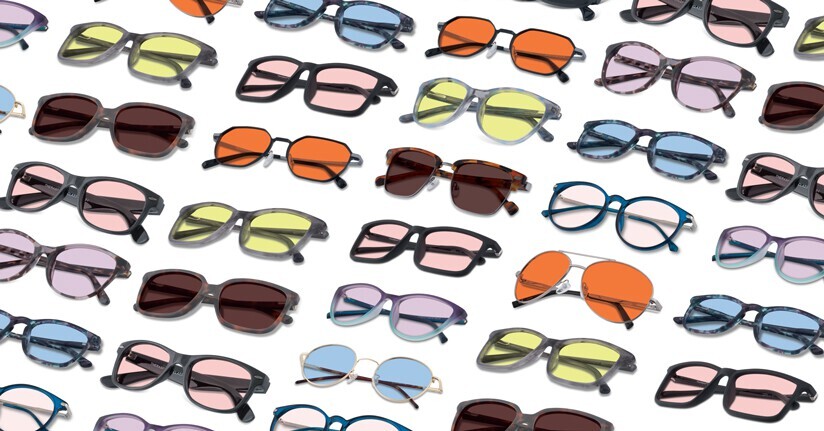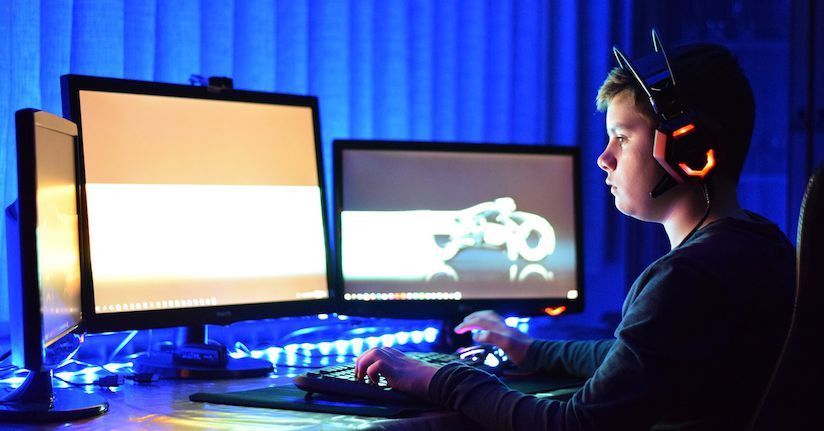4 Ways Blue Light Impacts Your Eyes and Brain
You have probably heard that exposure to blue light affects your health, whether it is from fluorescent lighting, your smartphone or even from the sun. There is definitely some truth to that statement, and we'll separate fact from fiction and explore what the research really says about how blue light impacts your eyes and your brain.

Blue Light Can Cause Headaches and Migraines
There are countless clinical studies that support the harmful effects that blue light can have for people who are prone to headaches or migraine attacks. Researchers have suggested that there is a specific neural pathway from the eyes to the brain—separate from how vision is transmitted—that ultimately causes blue light wavelengths to worsen headache pain and other symptoms. Others have pinpointed the exact wavelength to be in and around 480nm; it is exposure to this blue light that leads to high discomfort, a greater perception of pain and throbbing and even enhanced spreading of headache pain across the brain.1-3 And that does not even take into account that this color of light can increase other symptoms of migraine too, including: aura symptoms, photophobia and light sensitivity, dizziness/nausea, and more.
Blue Light Can Lead to Computer Vision Syndrome, Eye Strain
Does your job require you to stare at a computer for the majority of the day? If so, then you are absorbing a significant amount of blue light that can ultimately spell trouble for your eyes. Smartphone devices can also be problematic, and lead to eye fatigue and soreness—both of which are hallmark symptoms of computer vision syndrome and eye strain.4 In addition, blue light from computer use has been shown to worsen symptoms of dry eye as well. And the problems associated with these eye disorders are compounded the more you are exposed to light sources that emit high amounts of blue wavelengths.5-6
Blue Light Can Negatively Affect Your Sleep
Artificial light has long been connected to disruption in sleeping patterns, so it should not be surprising that blue light is one of the prime culprits. More specifically, people who view a significant amount of these wavelengths in the evening hours are inhibiting the production of a hormone called melatonin, which regulates our desire for sleep. Looking at your mobile device for an extended period of time before bed has been shown to elicit greater drowsiness, lower energy and alertness the next day.7-8
Blue Light May Damage Your Eyes
This remains a controversial finding, but there is some evidence that the ultraviolet UVA light (which is abundant in high-energy blue light) can damage the retina of your eyes.9-10 The absorption of UVA light by the eye can lead to the destruction of specific membranes, and may also accelerate the development of cataracts and macular degeneration. However, it is important to note that these issues often occur as a result of longer duration of exposure.11
There Are Benefits to Blue Light Too
With all this negativity surrounding blue light, it may seem odd to learn that there can also be some benefits. For instance, it has been shown to improve alertness, productivity, and even memory.12 It makes sense too—blue light suppresses melatonin which would otherwise facilitate sleepiness, so looking at it during the day would conversely make you feel more awake and attentive. Interestingly, blue light therapy has been used as a non-drug treatment for various conditions, notably concussion.13 However, we have to mention that these are clinical studies whereby the amount of blue wavelengths can be precisely controlled. With the sheer prevalence of artificial light that we encounter (fluorescents, screens, etc.) as well as the blue light from the sun, it can be much more difficult to regulate our exposure in a more natural setting.
How Can You Reduce Blue Light Exposure?
The last thing you want to do is shut yourself in the dark because that can have physical and emotional consequences, so what are you options? Here are some ways that you can minimize the damaging effects of blue light:
- Try "blue blocker" or blue-light filtering glasses, but don’t settle for cheap knock offs. TheraSpecs are a great brand, particularly if you already have migraine or another light-sensitive condition.
- Use "night mode" or similar apps that are native settings on your phone and your computer. This can warm the lighting on your device and make it easier on the eyes.
- Turn your phone or computer off at least 2-3 hours before you go to bed.
- Change your light bulbs to warmer tones and colors. Opt for more natural light if possible and avoid/remove fluorescents, if appropriate.
- Give your eyes a break. Look away from your screen at least once every 20 minutes to let your eyes reset. And don’t forget to blink!
Read More:
How Light Can Trigger or Worsen Migraine Attacks
The Impact of LCD Screens on Post-Concussion Syndrome
Techniques for Avoiding Computer Eye Strain
References:
1Noseda R, Bernstein CA, Nir R-R, et al. Migraine photophobia originating in cone-driven retinal pathways. Brain. 2016;139(7):1971-1986. doi:10.1093/brain/aww119.
2Main A, Vlachonikolis I, Dowson A. The wavelength of light causing photophobia in migraine and tension-type headache between attacks. Headache. 2000 Mar;40(3):194-9.
3M. Tatsumoto, T. Eda, T. Ishikawa, M. Ayama, K. Hirata. Light of Intrinsically Photosensitive Retinal Ganglion Cell (ipRGC) Causing Migraine Headache Exacerbation. IHC symposium OR3. 2013 June.
4Kim DJ, Lim C-Y, Gu N, Park CY. Visual Fatigue Induced by Viewing a Tablet Computer with a High-resolution Display. Korean Journal of Ophthalmology : KJO. 2017;31(5):388-393. doi:10.3341/kjo.2016.0095.
5Ranasinghe P, Wathurapatha WS, Perera YS, et al. Computer vision syndrome among computer office workers in a developing country: an evaluation of prevalence and risk factors. BMC Research Notes. 2016;9:150. doi:10.1186/s13104-016-1962-1.
6Kaido M, Toda I, Oobayashi T, Kawashima M, Katada Y, Tsubota K. Reducing Short-Wavelength Blue Light in Dry Eye Patients with Unstable Tear Film Improves Performance on Tests of Visual Acuity. Stieger K, ed. PLoS ONE. 2016;11(4):e0152936. doi:10.1371/journal.pone.0152936.
7Kayaba M, Iwayama K, Ogata H, et al. The effect of nocturnal blue light exposure from light-emitting diodes on wakefulness and energy metabolism the following morning. Environmental Health and Preventive Medicine. 2014;19(5):354-361. doi:10.1007/s12199-014-0402-x.
8Chang A-M, Aeschbach D, Duffy JF, Czeisler CA. Evening use of light-emitting eReaders negatively affects sleep, circadian timing, and next-morning alertness. Proceedings of the National Academy of Sciences of the United States of America. 2015;112(4):1232-1237. doi:10.1073/pnas.1418490112.
9Narimatsu T, Ozawa Y, Miyake S, Kubota S, Yuki K, Nagai N, Tsubota K. Biological effects of blocking blue and other visible light on the mouse retina. Clin Exp Ophthalmol. 2014 Aug;42(6):555-63. doi: 10.1111/ceo.12253. Epub 2013 Dec 4.
10Vicente-Tejedor J, Marchena M, Ramírez L, et al. Removal of the blue component of light significantly decreases retinal damage after high intensity exposure. Barnes S, ed. PLoS ONE. 2018;13(3):e0194218. doi:10.1371/journal.pone.0194218.
11Zrenner E. [Light-induced damage to the eye]. [Article in German] Fortschr Ophthalmol. 1990;87 Suppl:S41-51.
12Alkozei A, Smith R, Pisner DA, et al. Exposure to Blue Light Increases Subsequent Functional Activation of the Prefrontal Cortex During Performance of a Working Memory Task. Sleep. 2016;39(9):1671-1680. doi:10.5665/sleep.6090.
13Bajaj S, Vanuk JR, Smith R, Dailey NS, Killgore WDS. Blue-Light Therapy following Mild Traumatic Brain Injury: Effects on White Matter Water Diffusion in the Brain. Frontiers in Neurology. 2017;8:616. doi:10.3389/fneur.2017.00616.

TheraSpecs® Glasses for Light Sensitivity
Find the glasses that fit your needs and lifestyle, and stay protected from screens, fluorescents, unwanted blue light, sunlight, flashing lights, and more.
Shop Now



